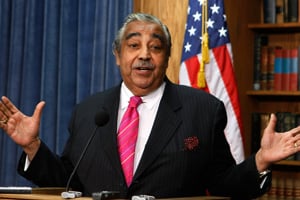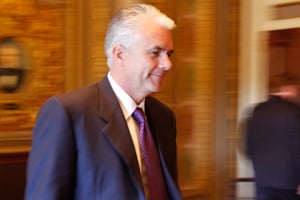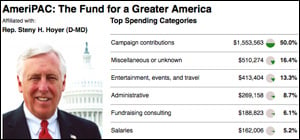
IPFS News Link • Corruption
Leadership PACs: Let the Good Times Roll
• Pro PublicaThe public might be forgiven for thinking the days are gone when lobbyists and special interests could pay for a lawmaker's cross-country golf outings. After all, both the House and Senate in 2007 responded to a spate of scandals by banning members of Congress from accepting gifts of any value from lobbyists or the companies that hire them.
But those reforms preserved a major loophole: leadership PACs like Chambliss' Republican Majority Fund [1], which have far looser rules and get far less scrutiny than campaign committees. At first, only a few rising stars in Congress had them. Now, 70 percent of the members do. So do a dozen former members.
In the past three election cycles, lobbyists and special interests poured $355 million into these funds, making them the second-largest source of political money for sitting members of Congress.
Legally, lawmakers are free to spend the leadership PAC money pretty much as they wish.
Leadership PACs have grown steadily since they began cropping up in the 1970s. What separates them from campaign committees is that lawmakers are supposed to pass along the bulk of the money to other members of their party for their campaigns. That way, lawmakers with leadership PACs can earn their beneficiaries' support when it comes time to divvy up committee chairmanships and other party leadership posts.
This system helps party leaders spread money to candidates with less money or tighter races. On the other hand, it also fuels the Washington money chase, allocates power in Congress based on fundraising prowess, and encourages lawmakers and lobbyists to mingle socially and recreationally as political money changes hands.
Of the $112 million that leadership PACs spent during the two-year campaign cycle that led up to the 2008 elections, less than half was passed on to candidates or party committees, according to a ProPublica analysis of Federal Election Commission data compiled by the Center for Responsive Politics. The rest paid for entertainment, administrative costs, fundraising and other categories that are so vague that it's impossible to know for sure how the money was spent.
"Some of the expenditures don't seem related to elections and politics," said Michael Malbin [3], executive director of the Campaign Finance Institute [4], a research center associated with George Washington University.
Indeed, funds have been used for visits to Churchill Downs, Disney World and the Country Music Hall of Fame. They've paid for funerals, flowers and farewell parties. Rep. Charles Rangel [5], D-N.Y., used $64,500 from his PAC to commission a portrait of himself.
All this is legal, even if it appears to make a mockery of the 2007 ethics reforms and the contribution limits at the very heart of the Federal Election Campaign Act of 1971 [6].
The Federal Election Commission (FEC) [7], which enforces federal campaign finance laws, has no rule against politicians using the money for personal purposes. Senate ethics rules don't even mention leadership PACs. The Senate interprets that silence to mean its ethics committee has no jurisdiction over leadership PACs whatsoever. The House, on the other hand, extends the same personal spending rules it applies to campaign committees to leadership PACs -- but there are no known instances when the policy has been enforced.

Rep. Charles Rangel, chairman of the House Ways and Means Committee, used money from his leadership PAC to commission a portrait of himself. (Mark Wilson/Getty Images)
"But that's going to be very difficult because so many members of Congress have them now," McGehee said. "Because they're such useful political slush funds, money that a politician controls totally with very few rules governing how they're used, it's very difficult to find members who want to take that on."
Former FEC Commissioner Brad Smith, who generally opposes tighter campaign finance rules, nonetheless favors getting rid of leadership PACs. He says they give incumbents an unfair advantage because challengers typically can't raise the maximum amount of money allowed for their campaign committees, much less for a leadership PAC.
"For the most part, it's really kind of an incumbent racket," said Smith, who's now a professor at Capital University Law School in Columbus, Ohio.
In March, the FEC's six commissioners, three Democrats and three Republicans, sent Congress a list of legislative recommendations, including one to prohibit personal use of leadership PAC funds. Their letter went to House Speaker Nancy Pelosi and Vice President Joe Biden, in his capacity as president of the Senate. It also was sent to members of the House and Senate committees that oversee the FEC.
So far, the FEC has gotten no response. ProPublica left messages at the offices of the speaker, the majority leader and the chairmen of the two committees seeking comment, but got no replies.
"I am not hearing anything being done on the legislative front on leadership PACs," said Craig Holman, the legislative representative of the consumer advocacy group Public Citizen [9].
Party Building or Fun and Games?
Democrats and Republicans alike use leadership PAC funds for play.
Among Democrats, Senate Majority Leader Harry Reid [10] of Nevada used his leadership PAC to entertain at Las Vegas casinos, including $32,985 at the Bellagio and $24,284 at Caesars. Sen. Charles Schumer [11] of New York paid $32,760 to the New York Yankees and $14,490 to the New York Giants.
Among Republicans, former Sen. Gordon Smith [12] of Oregon, who was defeated last fall for re-election, spent $91,004 at the Bandon Dunes Golf Resort. Former Rep. Thomas Reynolds [13] of New York spent $66,378 at Pebble Beach.
The FEC disclosure forms that leadership PACs file are so cursory that lawmakers don't have to disclose who participated or contributed at a PAC fundraiser, the day the event was held or how much money was raised.
Chambliss' leadership PAC ran up a $50,394 bill at the Ritz-Carlton Naples on Jan. 25, 2008. The only note of explanation was the stated purpose, "PAC EVENT/LODGING/BANQUET/GOLF."
"The problem is that sometimes it's hard to tell the personal from the political," said FEC Commissioner Ellen Weintraub.

Sen. John Ensign's leadership PAC, Battle Born PAC, paid Cynthia Hampton, the woman Sen. Ensign admitted to having an affair with, $23,138. (Harry Hamburg/AP Photo)
Former North Carolina senator and Democratic presidential candidate John Edwards [14] used his leadership PAC to pay videographer Rielle Hunter's firm $114,000 in 2006 and 2007 to make a campaign video. Last year, he admitted he had an extramarital affair with Hunter during that period.
More recently, Sen. John Ensign [15], R-Nev., admitted to having an extramarital affair with a woman who was on his leadership PAC payroll. Cynthia Hampton received $23,138 from the PAC during the 2008 election cycle.
Chambliss' Golf PAC
Only a quarter of the more than $750,000 that Chambliss' PAC spent during the 2008 cycle -- about $200,000 -- went to help GOP candidates. The rest went for golf, including payments to resorts and transportation -- a private jet on one occasion and limos on another. In July, ABC News cameras captured shots of Chambliss and other lawmakers golfing at the five-star Greenbrier resort in West Virginia.
• Want to see how your congress members are using their leadership PACs? Search ProPublica's Leadership PAC Tracker.

























